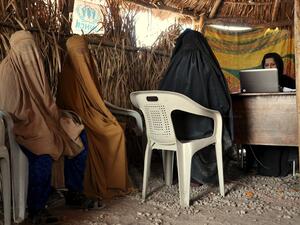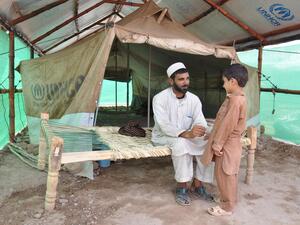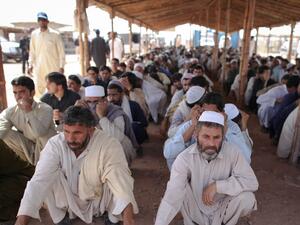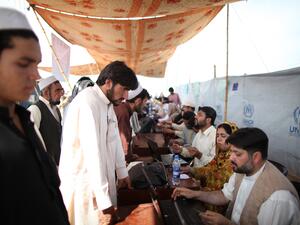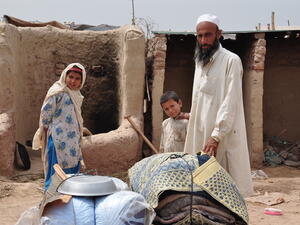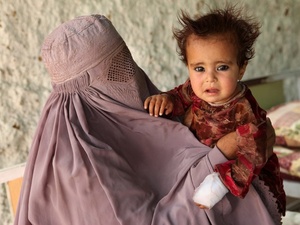Notorious Jalozai refugee camp finally closes; Lubbers hails move
Notorious Jalozai refugee camp finally closes; Lubbers hails move
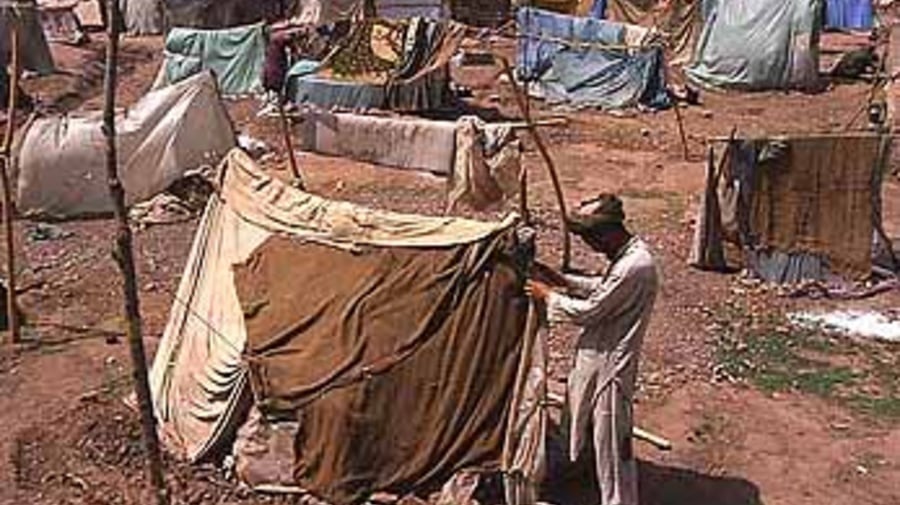
The squalid Jalozai camp near Peshawar, which was finally closed Tuesday.
PESHAWAR, Pakistan, Feb. 12 (UNHCR) - The last convoy of Afghans left the Jalozai refugee camp Tuesday, marking the close of the notoriously squalid site where up to 80,000 thousand people lived and many died in deleterious conditions.
The close of the camp was a key goal of the United Nations High Commissioner for Refugees, which a year ago transferred some 60,000 people out of Jalozai only to see it fill up again with desperate Afghans fleeing their country. Since November, another 45,000 people were moved out to five new camps established by the refugee agency.
"For much of the past year, Jalozai was tragic and visible evidence of the miserable plight of Afghans fleeing decades of war, abuse, drought, and deprivation," High Commissioner Ruud Lubbers said in a statement from the agency's headquarters in Geneva. "Jalozai's very existence was a sad reminder of the international community's neglect of the Afghan situation prior to the events of September 11."
Senior Pakistani government and provincial officials as well United Nations representatives were on hand Tuesday to see the last buses pull out of the camp with 1,570 refugees and start the journey to three recently opened camps - Barkili, Shalman, and Asgharo - all located near the border with Afghanistan.
Jalozai, situated some 40 kilometres east of the Pakistani city of Peshawar, first became a precarious and unhealthy home to tens of thousands of Afghans in late 2000. The refugees constructed crude shelters made of canvas and plastic on ground that often flooded when it rained.
The Pakistani government, already hosting more than two million refugees largely forgotten by the international community, was reluctant to officially recognise the new arrivals. International aid agencies were not allowed to register the refugees. Many died, especially children, as relief workers struggled to provide minimum health and other services.
"The site itself was too small for that kind of population," said Mohammed Adar, a UNHCR senior emergency officer, referring to the camp's small area where up to 80,000 people were crammed together. "There was simply not enough space to dig the latrines that were required and to put in the shelters that were necessary."
"For the people who have spent the last 12 months in Jalozai, I think this has been a very bitter experience," Adar added. "They have lost quite a number of children there, and I would think that anybody who has been in the camp would wish that it had been closed a long time ago."
Numerous agencies, non-governmental organisations and private donors, including UNHCR, the World Food Programme, Médecins Sans Frontières, the International Rescue Committee and Shelter Now International, provided whatever help they could. But Jalozai's poor location that made it prone to flooding, and its cramped, haphazard layout made it difficult to provide the Afghans with appropriate assistance.
It was not until the September 11 attacks on the United States that international attention focused on the plight of the 3.5 million Afghan refugees in Pakistan and Iran and consequently on programmes to assist them. UNHCR received approval from the Pakistani government to establish 14 camps and a transit centre along the country's border with Afghanistan, making the relocation of those in Jalozai possible.
More than 190,000 Afghans are currently housed in the new camps, where they can receive proper medical care and adequate food and shelter. The agency says the new sites can handle up to 250,000 people and that it will continue to relocate those refugees that request it into the camps.
The agency has announced plans to help about 1.2 million of the refugees and internally displaced persons within Afghanistan return home this year in a repatriation programme scheduled to begin in late March. Last week, UNHCR announced that it would start delivering return kits to Afghans who decide to return home spontaneously.
Since January 1, some 26,000 Afghans have repatriated from Iran and another 80,000 have gone back from Pakistan. At the same time, however, 25,000 mostly ethnic Pashtun refugees arrived at the Chaman border crossing in Pakistan, saying they fled the insecure conditions that prevail in parts of the country, attacks from other ethnic groups, and the lack of aid in some areas.
High Commissioner Lubbers, who visited the Jalozai camp last Spring and made its closing a key priority of his first year in office, said Tuesday that "by finally emptying it today, we are demonstrating the international community's renewed commitment to help end the suffering of the Afghan people."


